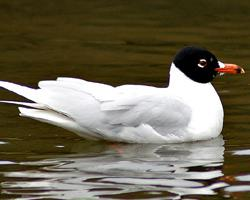
State of endangerment
| Endangered |
Animal description
The Andean gull (Chroicocephalus serranus) is a fascinating and somewhat elusive bird species predominantly found in the high-altitude regions of South America. This species is a part of the Laridae family, which encompasses gulls, terns, and skimmers. The Andean gull possesses several unique characteristics and behaviors that distinguish it from other members of its family.Physical Description:
The Andean gull is a medium-sized bird, with a body length typically ranging between 40 to 45 centimeters. It has a slender build and exhibits a somewhat elegant appearance. The plumage of this bird is predominantly white, with a distinctive grey back and upper wings. The tips of its wings are black, creating a striking contrast against its lighter body color. One of the most notable features of the Andean gull is its bill, which is bright red with a black tip, a characteristic that is especially vivid during the breeding season. The legs and feet of the Andean gull are also red, adding to its distinctive appearance. Its eyes are surrounded by a narrow, incomplete white ring, giving it a sharp, keen look.
Habitat and Distribution:
The Andean gull is aptly named for its preferred habitat in the Andean mountains. It is predominantly found at altitudes ranging from 3,000 to 4,500 meters above sea level. Its range extends from the northern parts of South America, in countries such as Colombia and Venezuela, down through Ecuador, Peru, Bolivia, Chile, and into Argentina. The Andean gull favors freshwater or brackish environments, including lakes, rivers, and marshes, within these high-altitude regions.
Behavior and Diet:
The Andean gull is an omnivorous bird, with a diet that includes a variety of food sources. It feeds on insects, small fish, and crustaceans, as well as plant material. The bird is known for its opportunistic feeding behavior, often scavenging for food in addition to hunting. It is particularly adept at catching flying insects in mid-air.
Breeding and Nesting:
Breeding season for the Andean gull occurs during the warmer months, when pairs engage in elaborate courtship displays that include vocalizations and aerial acrobatics. Nests are typically constructed on the ground, often on islands in lakes or isolated spots along riverbanks, providing protection from predators. The nests are made from plant material and are lined with softer materials for the eggs. Females usually lay 2 to 3 eggs, which both parents then incubate. The chicks are precocial, meaning they are relatively mature and mobile from the moment of hatching. However, they remain dependent on their parents for food and protection for several weeks.
Conservation Status:
The Andean gull is currently classified as Least Concern by the International Union for Conservation of Nature (IUCN). While the species is not currently facing significant threats, its reliance on specific high-altitude habitats makes it potentially vulnerable to environmental changes, including climate change and habitat degradation due to human activities.
In summary, the Andean gull (Chroicocephalus serranus) is a distinctive and intriguing species, adapted to life in the harsh environments of the high Andes. Its unique physical characteristics, combined with its specialized habitat preferences and behaviors, make it a remarkable example of avian adaptation and resilience.
Similar Animals
New photos of animals
Top 10 animals
- Dolphin gull (Leucophaeus scoresbii)
- Diana monkey (Cercopithecus diana)
- Moustached guenon (Cercopithecus cephus)
- Galápagos tortoise (Geochelone nigra complex)
- Stone loach (Barbatula barbatula)
- Japanese macaque (Macaca fuscata)
- Greek tortoise (Testudo graeca)
- Russian tortoise (Testudo horsfieldii)
- Common flying dragon (Draco volans)
- Galápagos penguin (Spheniscus mendiculus)


